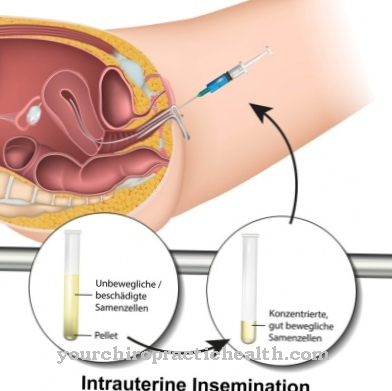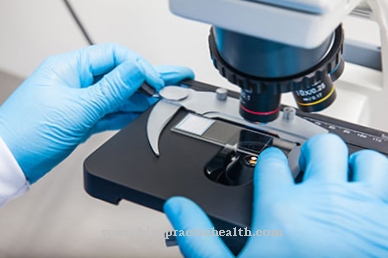Trichomoniasis belongs to the sexually transmitted diseases. It is caused by a micro-parasite and affects vaginal tissues and the urinary tract. Trichomoniasis shows symptoms mainly in women, although men are also carriers, but mostly get symptom-free.
What is trichomoniasis?
.jpg)
© Artemida-psy - stock.adobe.com
The trigger for Trichomoniasis is an infection with Trichomonas vaginalis, a flagellum with an average size of 15 micrometers. The route of infection is sexual contact with the vaginal mucous membranes. Trichomonads infection is one of the most common infectious diseases in sexual intercourse worldwide.
The treatment is straightforward and is carried out in both sexual partners at the same time to avoid recurring trichomonas infections. What is noticeable about trichomoniasis is that men only very rarely have any noticeable symptoms in the event of an infection. It almost exclusively affects women who can suffer from discharge, itching and other symptoms due to the trichomonads infection.
causes
To the disease Trichomoniasis it happens when a person infected with Trichomonas vaginalis transfers the parasitic flagellates to the mucous membranes of their sexual partner through sexual contact.
These trichomonads settle on the vaginal mucous membrane and supply themselves with nutrients through it. The parasite destroys the natural vaginal flora and causes damage to the mucous membrane. Trichomoniasis is difficult to recognize at first, as in the majority of cases it remains symptom-free for a long period of time. During this time, carriers can continue to spread them unhindered during sexual intercourse.
Trichomoniasis can increase in the body unnoticed and the number of trichomonads initially increases. In contrast, pure body contact without involvement of the vaginal mucous membranes does not cause a trichomonad infection. The use of condoms protects but does not guarantee against trichomoniasis.
Typical symptoms & signs
- Vaginal inflammation
- Itching
- Burning sensation in the vagina (vaginal burning)
- Vaginal discharge
- Pain and burning sensation when urinating
- Frequent urination
Diagnosis & course
The Trichomoniasis is diagnosed in female patients by a vaginal smear. The pear-shaped parasites are clearly visible under the microscope and enable a clear diagnosis.
Treatment should always be given if trichomoniasis is detected, as the symptoms can be painful and uncomfortable for the patient. In addition to a strong smelling discharge, trichomoniasis manifests itself as itching. In men and women alike, the spread into the urethra eventually caused increasing pain when urinating. If the infestation is severe, women can become temporarily infertile.
It is seldom so severe that the trichomonads infection leads to fever and physical weakness. The uterus and the urinary bladder are also only affected by trichomoniasis in exceptional cases. In the majority of cases, men are only carriers of the trichomonads infection and show no symptoms.
Complications
Trichomoniasis leads to a number of very unpleasant complaints, all of which have a very negative effect on the patient's quality of life. As a rule, those affected suffer from vaginal inflammation. This leads to severe reddening of the skin and also to itching of the skin. There may also be a burning sensation or a discharge from the vagina. In many cases, patients also experience painful urination.
This pain also leads to psychological complaints or to depression. Frequent urination is also noticeable, which has a negative effect on the everyday life of the person concerned. If left untreated, trichomoniasis can still lead to infertility. Many patients also suffer from a fever or general physical weakness.
Trichomoniasis can usually be treated well with the help of medication and antibiotics. There are no particular complications. The life expectancy of the patient is also not negatively affected by successful treatment. If the disease occurs again, however, those affected have to rely on renewed treatment. The partner should also undergo treatment because the disease is sexually transmitted.
When should you go to the doctor?
In order to prevent further complications or complaints from trichomoniasis, an examination and treatment by a doctor should definitely be carried out for this disease. Only through early detection and treatment can further worsening of symptoms be limited. Therefore, with trichomoniasis, a doctor should be consulted at the first symptoms and complaints.
The doctor should be contacted if the affected person suffers from severe itching and severe burning in the vagina. This is self-inflamed and can also be painful in many cases. Frequent urination often indicates trichomoniasis and should also be examined by a doctor. Most people also experience discomfort or pain when urinating. If the symptoms of trichomoniasis occur, a general practitioner should be consulted directly. The disease can usually be treated well.
Treatment & Therapy
The Trichomoniasis While one of the most common sexually transmitted infectious diseases, it is easy to treat. Once the diagnosis has been made, suitable drugs are available to the doctor specifically for combating the parasites.
These are prescription antibiotics that can be administered intravaginally or orally. The drugs do not require any further supplementation in the treatment of trichomoniasis as long as they are taken for the necessary period of time according to the doctor's instructions.
Every patient is strongly advised against exclusively self-treatment with alternative remedies and methods. This infection needs to be treated quickly and under medical supervision. If the transmitting sexual partner is known and can be reached, it is necessary that he too can be treated for trichomoniasis.
It does not matter whether he has symptoms. The partner treatment serves to rule out a new infection during the next sexual contact. After the treatment with antibiotics, the vaginal flora should be rebuilt, as it is damaged by the fight against trichomoniasis.
prevention
Against Trichomoniasis the only really effective protection would be total abstinence. Since this is hardly reasonable for a patient, at least the use of condoms and thorough personal hygiene before and after sexual intercourse is recommended. Formerly ill people must pay particular attention to protection during sexual intercourse with alternating sexual partners, since the trichomonads infection can lead to an increased susceptibility to HIV infections due to the scarring of the vaginal tissue.
Aftercare
If trichomoniasis has been successfully treated, regular follow-up examinations should follow in order to identify and treat a new infection as well as secondary diseases at an early stage. The follow-up examination for women consists of regular checks of the vaginal mucosa and vaginal secretion using smears made by the gynecologist.
In addition, imaging procedures (ultrasound) can ensure that the uterus is not infected. In addition, follow-up treatment with lactic acid bacteria may be indicated to restore the normal vaginal flora. This is especially the case if persistent vaginal dryness combined with itching is present even after the treatment of trichomoniasis.
To prevent re-infection, both partners should avoid unprotected sexual intercourse with several people. Unprotected sexual intercourse must be avoided, especially in the first few weeks after infection, as the infection, like antibiotic therapy, weakens the immune system and increases the likelihood of contracting HIV viruses (AIDS).
Men should have regular swabs of their penile foreskin, especially if unprotected sexual intercourse with alternating partners is not stopped, to ensure that there is no new infection with trichomonads. In addition, a semen sample should be examined for fertility after trichomoniasis, as the infection can in rare cases affect the seminal vesicles, which can lead to infertility.
You can do that yourself
The effects of an infection with trichomonads on everyday life depend heavily on the sex of the person affected. Many men are hardly restricted by this. However, since inflammation can still occur, they should initially refrain from sexual intercourse or masturbation.
Even after all symptoms have subsided, affected men should use condoms. The infection is contagious for a long time. Within a partnership, there is a risk of the ping-pong effect if both partners are affected. In women, the symptoms are often so intense that they are severely restricted in their everyday lives.
The most important self-help measure is not to give in to intense itching. Scratching or rubbing the affected areas should be avoided at all costs. In addition, strict hygiene is necessary. Sanitary towels, panty liners and underwear must be changed regularly. The intimate area should be cleaned daily with water but without soap.
Self-treatment of the infection is in any case not advisable. Most common home remedies have a negative impact on the course of the disease. Treatment with vinegar, tea tree oil, or yogurt can cause severe irritation. After trichomoniasis has been successfully treated with medication, the person affected can prevent a renewed infection with a lactic acid bacterial treatment.












.jpg)



.jpg)










.jpg)
